boot SKODA YETI 2011 1.G / 5L User Guide
[x] Cancel search | Manufacturer: SKODA, Model Year: 2011, Model line: YETI, Model: SKODA YETI 2011 1.G / 5LPages: 252, PDF Size: 3.61 MB
Page 57 of 252

Automatic wipe/wash for windscreen
тАУ
Pull the lever towards the steering wheel into sprung position 5 , the wash
system sprays immediately, the windscreen wiper starts wiping a little later.
The wash system and the windscreen wiper operate simultaneously at a
speed of more than 120 km/h.
тАУ Release the lever. The windscreen wash system stops and the wiper contin-
ues for another 3 - 4 wiper strokes (depending on the period of spraying of the
windscreen). At a speed of more than 2 km/h, the wiper wipes once again 5
seconds after the last wiper stroke in order to wipe the last drops from the
windscreen. This function can be activated/deactivated by a specialist garage.
Rain sensor
тАУ Move the lever into position 1 .
тАУ You can set the sensitivity of the sensor individually with switch A .
Wiping the rear window pane
тАУ Push the lever away from the steering wheel into position 6 - the windshield
wiper will operate every 6 seconds.
Automatic wipe/wash for the rear window pane
тАУ Press the lever from the steering wheel forward into the sprung position 7 ,
the wash system sprays immediately, the windscreen wiper starts wiping a lit-
tle later. As long as you hold the lever in this position, the wiper operates as
well as the wash system.
тАУ Letting go of the lever will cause the windscreen wash system to stop and the
wiper to continue for another 2 - 3 wiper strokes (depending on the period of
spraying of the windscreen). The lever will stay in position after releasing it
6 .
Switching windscreen wipers off
тАУ Move the lever back into its home position 0 .
After the windscreen wiper switches off each time or the ignition switches off for
the third time, the position of the windscreen wiper changes, this counteracts an
early fatigue of the wiper rubbers. After starting the vehicle, the front window
wipers automatically move into the lower rest position. The windscreen wipers and the wash system only operate if the ignition is switch-
ed on and the bonnet is closed 1)
.
The rear window wiper operates only if the boot lid is closed.
If the intermittent wipe is switched on, the intervals are also controlled depending
on speed.
The rain sensor automatically regulates the break between the individual wiper
strokes depending on the intensity of the rain.
The rear window will be wiped again if the front window wipers are on when re-
verse gear is selected.
Top up with wash liquid тЗТтАКpage 199
.
Winter position
If the windscreen wipers are in rest position, they cannot be folded out from the
windscreen. For this reason we recommend adjusting the windscreen wipers in
winter so that they can be folded out from the windscreen easily. You can set this
rest position yourself as follows:
тЧП Switch on the windscreen wipers.
тЧП Switch off the ignition. The windscreen wipers remain in the position in which
they were when switching off the ignition.
You can also use the service position тЗТ
тАКpage 57 as a winter position. WARNING
тЧП Properly maintained windscreen wiper blades are essential for clear visibil-
ity and safe driving тЗТ
тАКpage 57.
тЧП Do not use the windscreen washer system at low temperatures, without
heating the windscreen beforehand. Otherwise the window cleaner could
freeze on the windscreen and restrict the view to the front.
тЧП The rain sensor only operates as a support. The driver is not released from
the responsibility to set the function of the windscreen wipers manually de-
pending on the visibility conditions. ┬г1)
On vehicles which do not have a contact switch for the bonnet, the windshield wiper and wash sys-
tem operates also when the bonnet is opened. 55
Lights and Visibility Using the system Safety Driving Tips General Maintenance Breakdown assistance Technical data
Page 72 of 252
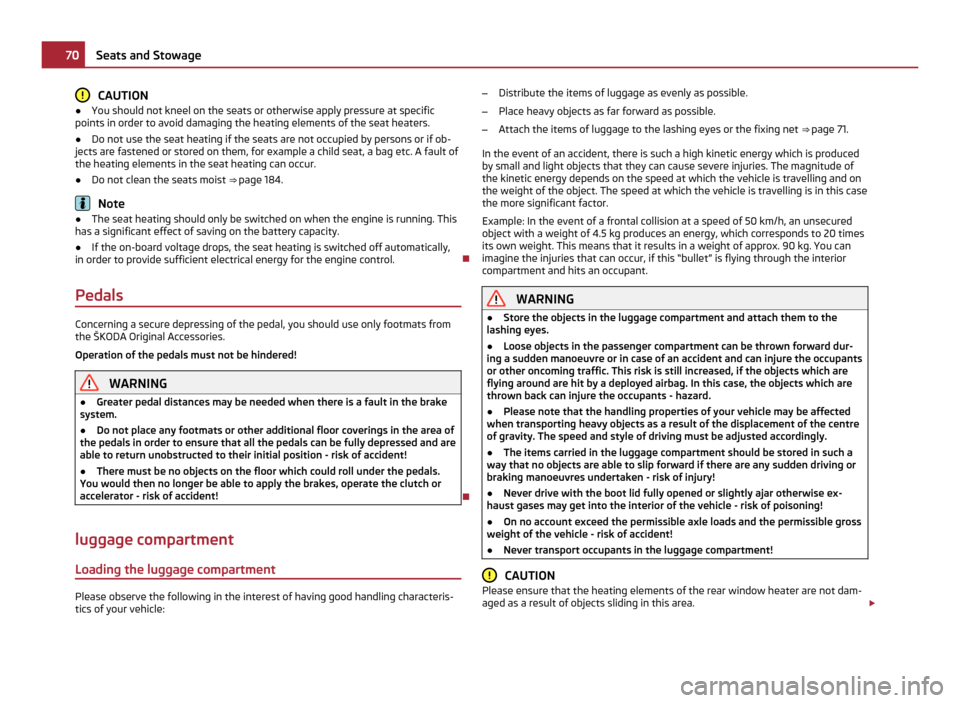
CAUTION
тЧП You should not kneel on the seats or otherwise apply pressure at specific
points in order to avoid damaging the heating elements of the seat heaters.
тЧП Do not use the seat heating if the seats are not occupied by persons or if ob-
jects are fastened or stored on them, for example a child seat, a bag etc. A fault of
the heating elements in the seat heating can occur.
тЧП Do not clean the seats moist тЗТтАКpage 184 .Note
тЧП The seat heating should only be switched on when the engine is running. This
has a significant effect of saving on the battery capacity.
тЧП If the on-board voltage drops, the seat heating is switched off automatically,
in order to provide sufficient electrical energy for the engine control. яГР
Pedals Concerning a secure depressing of the pedal, you should use only footmats from
the
┼аKODA Original Accessories.
Operation of the pedals must not be hindered! WARNING
тЧП Greater pedal distances may be needed when there is a fault in the brake
system.
тЧП Do not place any footmats or other additional floor coverings in the area of
the pedals in order to ensure that all the pedals can be fully depressed and are
able to return unobstructed to their initial position - risk of accident!
тЧП There must be no objects on the floor which could roll under the pedals.
You would then no longer be able to apply the brakes, operate the clutch or
accelerator - risk of accident! яГР
luggage compartment
Loading the luggage compartment Please observe the following in the interest of having good handling characteris-
tics of your vehicle: тАУ
Distribute the items of luggage as evenly as possible.
тАУ Place heavy objects as far forward as possible.
тАУ Attach the items of luggage to the lashing eyes or the fixing net тЗТ
тАКpage 71.
In the event of an accident, there is such a high kinetic energy which is produced
by small and light objects that they can cause severe injuries. The magnitude of
the kinetic energy depends on the speed at which the vehicle is travelling and on
the weight of the object. The speed at which the vehicle is travelling is in this case
the more significant factor.
Example: In the event of a frontal collision at a speed of 50 km/h, an unsecured
object with a weight of 4.5 kg produces an energy, which corresponds to 20 times
its own weight. This means that it results in a weight of approx. 90 kg. You can
imagine the injuries that can occur, if this тАЬbulletтАЭ is flying through the interior
compartment and hits an occupant. WARNING
тЧП Store the objects in the luggage compartment and attach them to the
lashing eyes.
тЧП Loose objects in the passenger compartment can be thrown forward dur-
ing a sudden manoeuvre or in case of an accident and can injure the occupants
or other oncoming traffic. This risk is still increased, if the objects which are
flying around are hit by a deployed airbag. In this case, the objects which are
thrown back can injure the occupants - hazard.
тЧП Please note that the handling properties of your vehicle may be affected
when transporting heavy objects as a result of the displacement of the centre
of gravity. The speed and style of driving must be adjusted accordingly.
тЧП The items carried in the luggage compartment should be stored in such a
way that no objects are able to slip forward if there are any sudden driving or
braking manoeuvres undertaken - risk of injury!
тЧП Never drive with the boot lid fully opened or slightly ajar otherwise ex-
haust gases may get into the interior of the vehicle - risk of poisoning!
тЧП On no account exceed the permissible axle loads and the permissible gross
weight of the vehicle - risk of accident!
тЧП Never transport occupants in the luggage compartment! CAUTION
Please ensure that the heating elements of the rear window heater are not dam-
aged as a result of objects sliding in this area. ┬г70
Seats and Stowage
Page 75 of 252
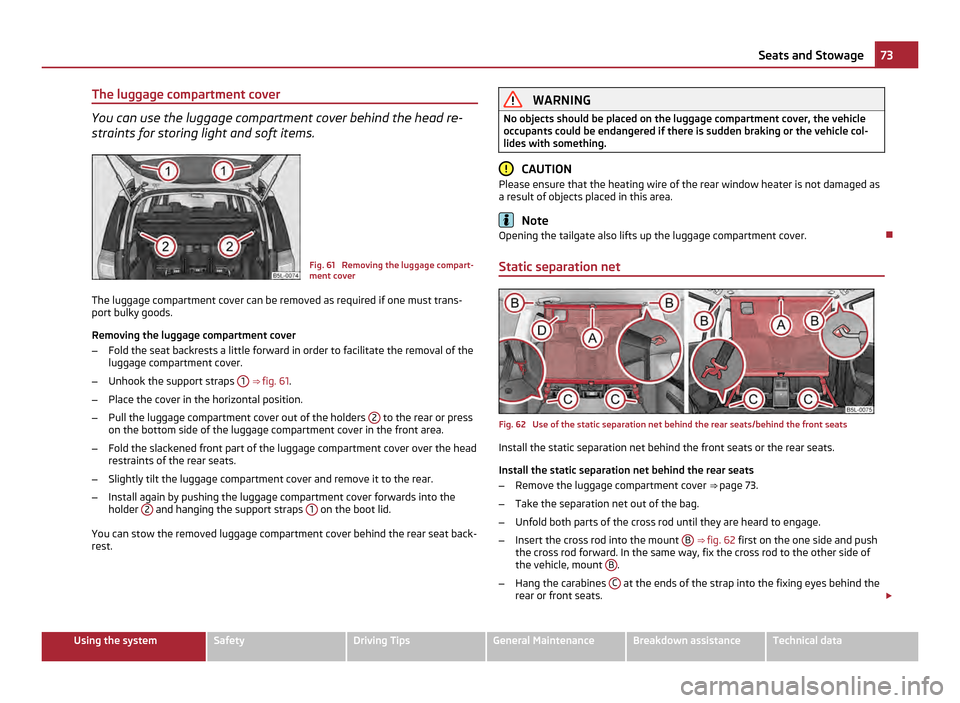
The luggage compartment cover
You can use the luggage compartment cover behind the head re-
straints for storing light and soft items.
Fig. 61 Removing the luggage compart-
ment cover
The luggage compartment cover can be removed as required if one must trans-
port bulky goods.
Removing the luggage compartment cover
тАУ Fold the seat backrests a little forward in order to facilitate the removal of the
luggage compartment cover.
тАУ Unhook the support straps 1
тЗТтАК fig. 61 .
тАУ Place the cover in the horizontal position.
тАУ Pull the luggage compartment cover out of the holders 2 to the rear or press
on the bottom side of the luggage compartment cover in the front area.
тАУ Fold the slackened front part of the luggage compartment cover over the head
restraints of the rear seats.
тАУ Slightly tilt the luggage compartment cover and remove it to the rear.
тАУ Install again by pushing the luggage compartment cover forwards into the
holder 2 and hanging the support straps
1 on the boot lid.
You can stow the removed luggage compartment cover behind the rear seat back-
rest. WARNING
No objects should be placed on the luggage compartment cover, the vehicle
occupants could be endangered if there is sudden braking or the vehicle col-
lides with something. CAUTION
Please ensure that the heating wire of the rear window heater is not damaged as
a result of objects placed in this area. Note
Opening the tailgate also lifts up the luggage compartment cover. яГР
Static separation net Fig. 62 Use of the static separation net behind the rear seats/behind the front seats
Install the static separation net behind the front seats or the rear seats.
Install the static separation net behind the rear seats
тАУ
Remove the luggage compartment cover тЗТ тАКpage 73.
тАУ Take the separation net out of the bag.
тАУ Unfold both parts of the cross rod until they are heard to engage.
тАУ Insert the cross rod into the mount B
тЗТтАК fig. 62 first on the one side and push
the cross rod forward. In the same way, fix the cross rod to the other side of
the vehicle, mount B .
тАУ Hang the carabines C at the ends of the strap into the fixing eyes behind the
rear or front seats. ┬г 73
Seats and Stowage Using the system Safety Driving Tips General Maintenance Breakdown assistance Technical data
Page 78 of 252
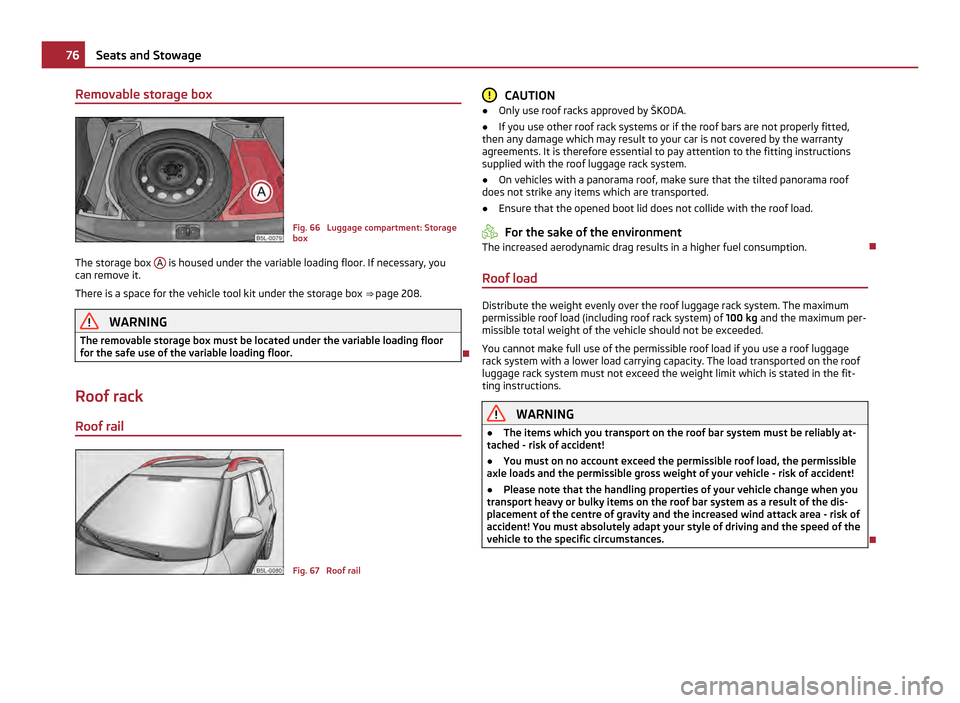
Removable storage box
Fig. 66 Luggage compartment: Storage
box
The storage box A is housed under the variable loading floor. If necessary, you
can remove it.
There is a space for the vehicle tool kit under the storage box тЗТ
тАКpage 208. WARNING
The removable storage box must be located under the variable loading floor
for the safe use of the variable loading floor. яГР
Roof rack
Roof rail Fig. 67 Roof rail CAUTION
тЧП Only use roof racks approved by
┼аKODA.
тЧП If you use other roof rack systems or if the roof bars are not properly fitted,
then any damage which may result to your car is not covered by the warranty
agreements. It is therefore essential to pay attention to the fitting instructions
supplied with the roof luggage rack system.
тЧП On vehicles with a panorama roof, make sure that the tilted panorama roof
does not strike any items which are transported.
тЧП Ensure that the opened boot lid does not collide with the roof load. For the sake of the environment
The increased aerodynamic drag results in a higher fuel consumption. яГР
Roof load Distribute the weight evenly over the roof luggage rack system. The maximum
permissible roof load (including roof rack system) of
100 kg and the maximum per-
missible total weight of the vehicle should not be exceeded.
You cannot make full use of the permissible roof load if you use a roof luggage
rack system with a lower load carrying capacity. The load transported on the roof
luggage rack system must not exceed the weight limit which is stated in the fit-
ting instructions. WARNING
тЧП The items which you transport on the roof bar system must be reliably at-
tached - risk of accident!
тЧП You must on no account exceed the permissible roof load, the permissible
axle loads and the permissible gross weight of your vehicle - risk of accident!
тЧП Please note that the handling properties of your vehicle change when you
transport heavy or bulky items on the roof bar system as a result of the dis-
placement of the centre of gravity and the increased wind attack area - risk of
accident! You must absolutely adapt your style of driving and the speed of the
vehicle to the specific circumstances. яГР76
Seats and Stowage
Page 87 of 252
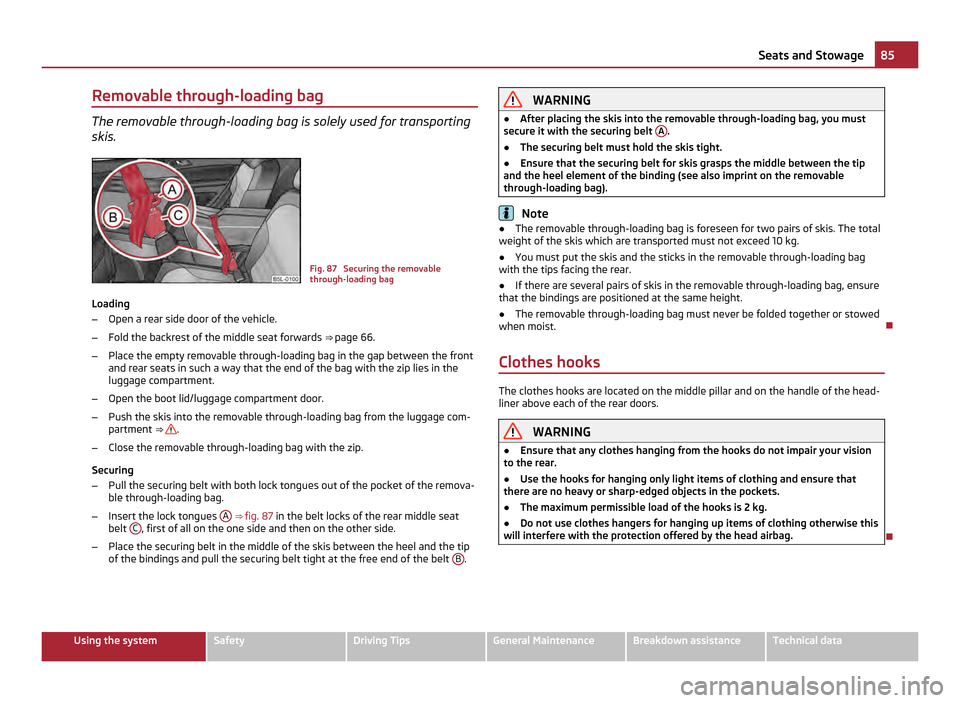
Removable through-loading bag
The removable through-loading bag is solely used for transporting
skis. Fig. 87 Securing the removable
through-loading bag
Loading
тАУ Open a rear side door of the vehicle.
тАУ Fold the backrest of the middle seat forwards тЗТ тАКpage 66.
тАУ Place the empty removable through-loading bag in the gap between the front
and rear seats in such a way that the end of the bag with the zip lies in the
luggage compartment.
тАУ Open the boot lid/luggage compartment door.
тАУ Push the skis into the removable through-loading bag from the luggage com-
partment тЗТтАК .
тАУ Close the removable through-loading bag with the zip.
Securing
тАУ Pull the securing belt with both lock tongues out of the pocket of the remova-
ble through-loading bag.
тАУ Insert the lock tongues A
тЗТтАК fig. 87 in the belt locks of the rear middle seat
belt C , first of all on the one side and then on the other side.
тАУ Place the securing belt in the middle of the skis between the heel and the tip
of the bindings and pull the securing belt tight at the free end of the belt B . WARNING
тЧП After placing the skis into the removable through-loading bag, you must
secure it with the securing belt A .
тЧП The securing belt must hold the skis tight.
тЧП Ensure that the securing belt for skis grasps the middle between the tip
and the heel element of the binding (see also imprint on the removable
through-loading bag). Note
тЧП The removable through-loading bag is foreseen for two pairs of skis. The total
weight of the skis which are transported must not exceed 10 kg.
тЧП You must put the skis and the sticks in the removable through-loading bag
with the tips facing the rear.
тЧП If there are several pairs of skis in the removable through-loading bag, ensure
that the bindings are positioned at the same height.
тЧП The removable through-loading bag must never be folded together or stowed
when moist. яГР
Clothes hooks The clothes hooks are located on the middle pillar and on the handle of the head-
liner above each of the rear doors.
WARNING
тЧП Ensure that any clothes hanging from the hooks do not impair your vision
to the rear.
тЧП Use the hooks for hanging only light items of clothing and ensure that
there are no heavy or sharp-edged objects in the pockets.
тЧП The maximum permissible load of the hooks is 2 kg.
тЧП Do not use clothes hangers for hanging up items of clothing otherwise this
will interfere with the protection offered by the head airbag. яГР85
Seats and Stowage Using the system Safety Driving Tips General Maintenance Breakdown assistance Technical data
Page 172 of 252
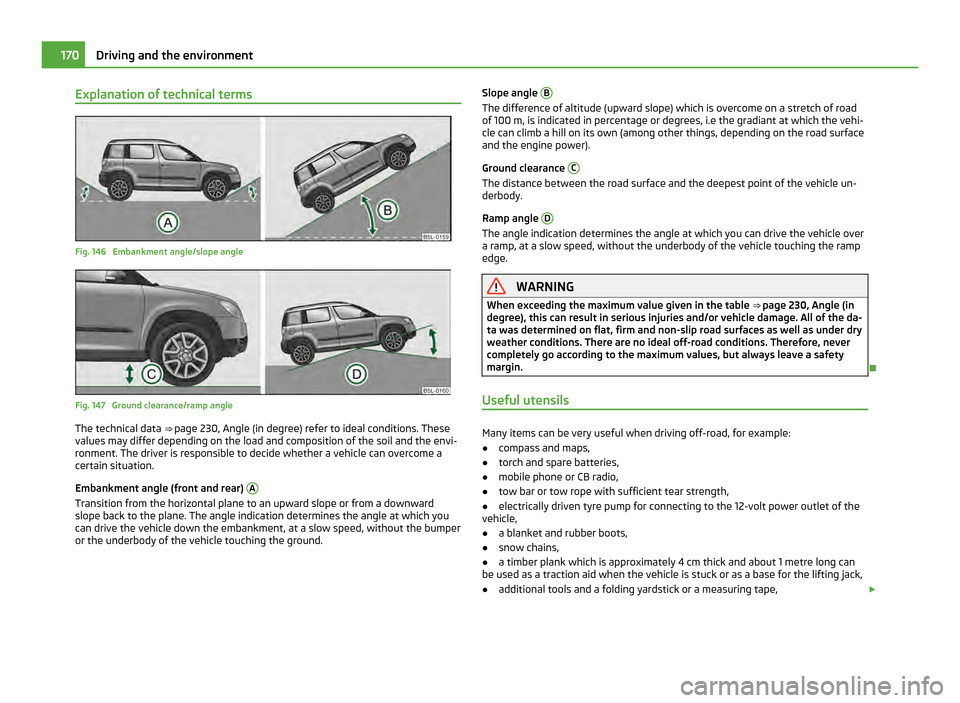
Explanation of technical terms
Fig. 146 Embankment angle/slope angle
Fig. 147 Ground clearance/ramp angle
The technical data
тЗТ
тАКpage 230, Angle (in degree) refer to ideal conditions. These
values may differ depending on the load and composition of the soil and the envi-
ronment. The driver is responsible to decide whether a vehicle can overcome a
certain situation.
Embankment angle (front and rear) ATransition from the horizontal plane to an upward slope or from a downward
slope back to the plane. The angle indication determines the angle at which you
can drive the vehicle down the embankment, at a slow speed, without the bumper
or the underbody of the vehicle touching the ground. Slope angle
B The difference of altitude (upward slope) which is overcome on a stretch of road
of 100 m, is indicated in percentage or degrees, i.e the gradiant at which the vehi-
cle can climb a hill on its own (among other things, depending on the road surface
and the engine power).
Ground clearance
C The distance between the road surface and the deepest point of the vehicle un-
derbody.
Ramp angle D The angle indication determines the angle at which you can drive the vehicle over
a ramp, at a slow speed, without the underbody of the vehicle touching the ramp
edge.
WARNING
When exceeding the maximum value given in the table тЗТ
тАКpage 230, Angle (in
degree), this can result in serious injuries and/or vehicle damage. All of the da-
ta was determined on flat, firm and non-slip road surfaces as well as under dry
weather conditions. There are no ideal off-road conditions. Therefore, never
completely go according to the maximum values, but always leave a safety
margin. яГР
Useful utensils Many items can be very useful when driving off-road, for example:
тЧП compass and maps,
тЧП torch and spare batteries,
тЧП mobile phone or CB radio,
тЧП tow bar or tow rope with sufficient tear strength,
тЧП electrically driven tyre pump for connecting to the 12-volt power outlet of the
vehicle,
тЧП a blanket and rubber boots,
тЧП snow chains,
тЧП a timber plank which is approximately 4 cm thick and about 1 metre long can
be used as a traction aid when the vehicle is stuck or as a base for the lifting jack,
тЧП additional tools and a folding yardstick or a measuring tape, ┬г170
Driving and the environment
Page 185 of 252
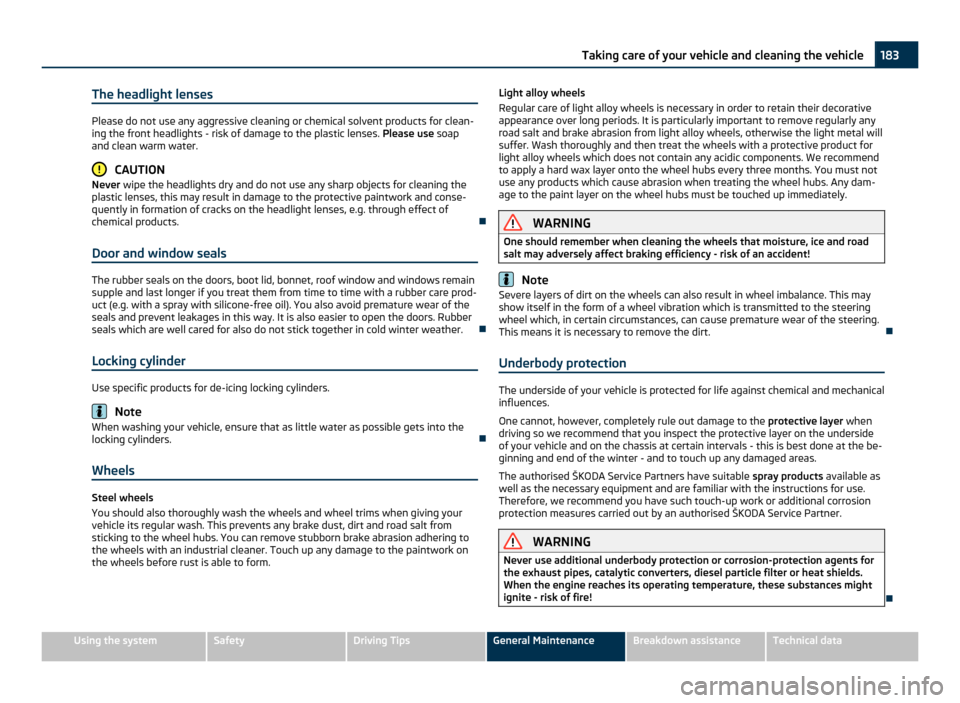
The headlight lenses
Please do not use any aggressive cleaning or chemical solvent products for clean-
ing the front headlights - risk of damage to the plastic lenses. Please use soap
and clean warm water. CAUTION
Never wipe the headlights dry and do not use any sharp objects for cleaning the
plastic lenses, this may result in damage to the protective paintwork and conse-
quently in formation of cracks on the headlight lenses, e.g. through effect of
chemical products. яГР
Door and window seals The rubber seals on the doors, boot lid, bonnet, roof window and windows remain
supple and last longer if you treat them from time to time with a rubber care prod-
uct (e.g. with a spray with silicone-free oil). You also avoid premature wear of the
seals and prevent leakages in this way. It is also easier to open the doors. Rubber
seals which are well cared for also do not stick together in cold winter weather.
яГР
Locking cylinder Use specific products for de-icing locking cylinders.
Note
When washing your vehicle, ensure that as little water as possible gets into the
locking cylinders. яГР
Wheels Steel wheels
You should also thoroughly wash the wheels and wheel trims when giving your
vehicle its regular wash. This prevents any brake dust, dirt and road salt from
sticking to the wheel hubs. You can remove stubborn brake abrasion adhering to
the wheels with an industrial cleaner. Touch up any damage to the paintwork on
the wheels before rust is able to form. Light alloy wheels
Regular care of light alloy wheels is necessary in order to retain their decorative
appearance over long periods. It is particularly important to remove regularly any
road salt and brake abrasion from light alloy wheels, otherwise the light metal will
suffer. Wash thoroughly and then treat the wheels with a protective product for
light alloy wheels which does not contain any acidic components. We recommend
to apply a hard wax layer onto the wheel hubs every three months. You must not
use any products which cause abrasion when treating the wheel hubs. Any dam-
age to the paint layer on the wheel hubs must be touched up immediately. WARNING
One should remember when cleaning the wheels that moisture, ice and road
salt may adversely affect braking efficiency - risk of an accident! Note
Severe layers of dirt on the wheels can also result in wheel imbalance. This may
show itself in the form of a wheel vibration which is transmitted to the steering
wheel which, in certain circumstances, can cause premature wear of the steering.
This means it is necessary to remove the dirt. яГР
Underbody protection The underside of your vehicle is protected for life against chemical and mechanical
influences.
One cannot, however, completely rule out damage to the protective layer
when
driving so we recommend that you inspect the protective layer on the underside
of your vehicle and on the chassis at certain intervals - this is best done at the be-
ginning and end of the winter - and to touch up any damaged areas.
The authorised ┼аKODA Service Partners have suitable spray products available as
well as the necessary equipment and are familiar with the instructions for use.
Therefore, we recommend you have such touch-up work or additional corrosion
protection measures carried out by an authorised ┼аKODA Service Partner. WARNING
Never use additional underbody protection or corrosion-protection agents for
the exhaust pipes, catalytic converters, diesel particle filter or heat shields.
When the engine reaches its operating temperature, these substances might
ignite - risk of fire! яГР183
Taking care of your vehicle and cleaning the vehicle Using the system Safety Driving Tips General Maintenance Breakdown assistance Technical data
Page 228 of 252
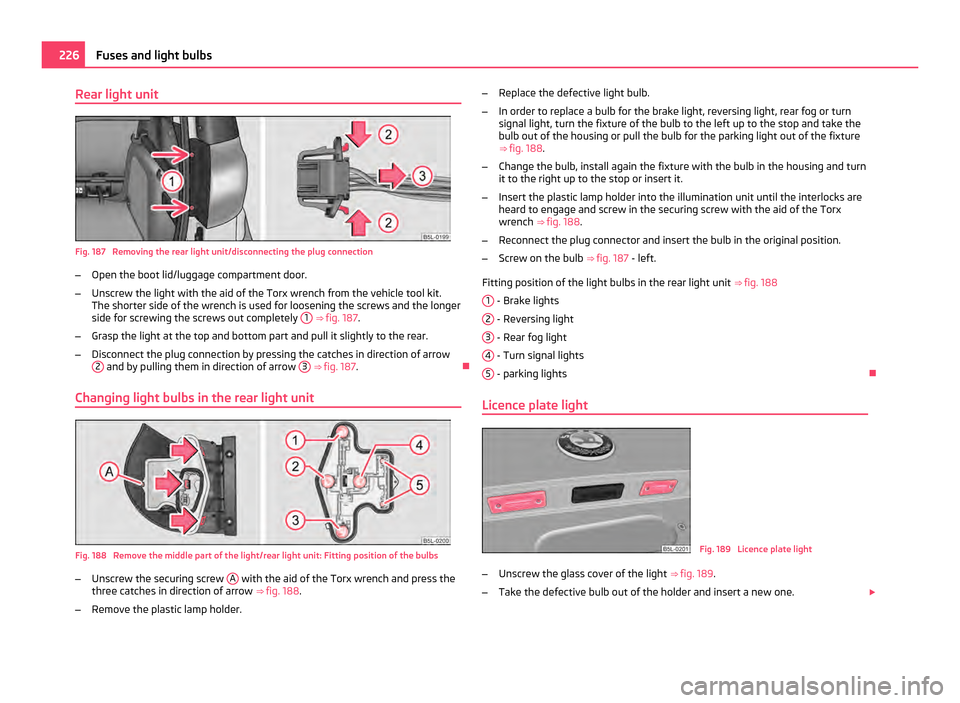
Rear light unit
Fig. 187 Removing the rear light unit/disconnecting the plug connection
тАУ Open the boot lid/luggage compartment door.
тАУ Unscrew the light with the aid of the Torx wrench from the vehicle tool kit.
The shorter side of the wrench is used for loosening the screws and the longer
side for screwing the screws out completely 1
тЗТ тАКfig. 187.
тАУ Grasp the light at the top and bottom part and pull it slightly to the rear.
тАУ Disconnect the plug connection by pressing the catches in direction of arrow
2 and by pulling them in direction of arrow
3
тЗТ
тАКfig. 187. яГР
Changing light bulbs in the rear light unit Fig. 188 Remove the middle part of the light/rear light unit: Fitting position of the bulbs
тАУ
Unscrew the securing screw A with the aid of the Torx wrench and press the
three catches in direction of arrow тЗТтАКfig. 188 .
тАУ Remove the plastic lamp holder. тАУ
Replace the defective light bulb.
тАУ In order to replace a bulb for the brake light, reversing light, rear fog or turn
signal light, turn the fixture of the bulb to the left up to the stop and take the
bulb out of the housing or pull the bulb for the parking light out of the fixture
тЗТтАКfig. 188 .
тАУ Change the bulb, install again the fixture with the bulb in the housing and turn
it to the right up to the stop or insert it.
тАУ Insert the plastic lamp holder into the illumination unit until the interlocks are
heard to engage and screw in the securing screw with the aid of the Torx
wrench тЗТ
тАКfig. 188 .
тАУ Reconnect the plug connector and insert the bulb in the original position.
тАУ Screw on the bulb тЗТ
тАКfig. 187 - left.
Fitting position of the light bulbs in the rear light unit тЗТтАКfig. 188
1 - Brake lights
2 - Reversing light
3 - Rear fog light
4 - Turn signal lights
5 - parking lights
яГР
Licence plate light Fig. 189 Licence plate light
тАУ Unscrew the glass cover of the light тЗТ
тАКfig. 189 .
тАУ Take the defective bulb out of the holder and insert a new one. ┬г226
Fuses and light bulbs
Page 242 of 252
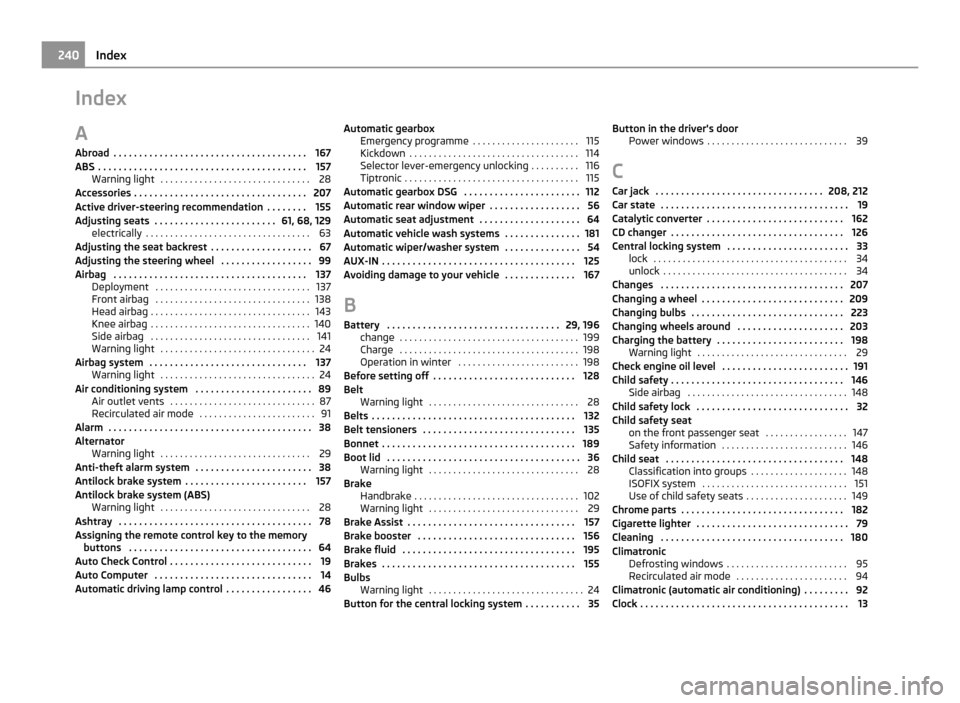
Index
A
Abroad . . . . . . . . . . . . . . . . . . . . . . . . . . . . . . . . . . . . . . 167
ABS . . . . . . . . . . . . . . . . . . . . . . . . . . . . . . . . . . . . . . . . . 157 Warning light . . . . . . . . . . . . . . . . . . . . . . . . . . . . . . . 28
Accessories . . . . . . . . . . . . . . . . . . . . . . . . . . . . . . . . . . 207
Active driver-steering recommendation . . . . . . . . 155
Adjusting seats . . . . . . . . . . . . . . . . . . . . . . . . 61, 68, 129 electrically . . . . . . . . . . . . . . . . . . . . . . . . . . . . . . . . . . 63
Adjusting the seat backrest . . . . . . . . . . . . . . . . . . . . 67
Adjusting the steering wheel . . . . . . . . . . . . . . . . . . 99
Airbag . . . . . . . . . . . . . . . . . . . . . . . . . . . . . . . . . . . . . . 137 Deployment . . . . . . . . . . . . . . . . . . . . . . . . . . . . . . . . 137
Front airbag . . . . . . . . . . . . . . . . . . . . . . . . . . . . . . . . 138
Head airbag . . . . . . . . . . . . . . . . . . . . . . . . . . . . . . . . . 143
Knee airbag . . . . . . . . . . . . . . . . . . . . . . . . . . . . . . . . . 140
Side airbag . . . . . . . . . . . . . . . . . . . . . . . . . . . . . . . . . 141
Warning light . . . . . . . . . . . . . . . . . . . . . . . . . . . . . . . . 24
Airbag system . . . . . . . . . . . . . . . . . . . . . . . . . . . . . . . 137 Warning light . . . . . . . . . . . . . . . . . . . . . . . . . . . . . . . . 24
Air conditioning system . . . . . . . . . . . . . . . . . . . . . . . 89 Air outlet vents . . . . . . . . . . . . . . . . . . . . . . . . . . . . . . 87
Recirculated air mode . . . . . . . . . . . . . . . . . . . . . . . . 91
Alarm . . . . . . . . . . . . . . . . . . . . . . . . . . . . . . . . . . . . . . . . 38
Alternator Warning light . . . . . . . . . . . . . . . . . . . . . . . . . . . . . . . 29
Anti-theft alarm system . . . . . . . . . . . . . . . . . . . . . . . 38
Antilock brake system . . . . . . . . . . . . . . . . . . . . . . . . 157
Antilock brake system (ABS) Warning light . . . . . . . . . . . . . . . . . . . . . . . . . . . . . . . 28
Ashtray . . . . . . . . . . . . . . . . . . . . . . . . . . . . . . . . . . . . . . 78
Assigning the remote control key to the memory buttons . . . . . . . . . . . . . . . . . . . . . . . . . . . . . . . . . . . . 64
Auto Check Control . . . . . . . . . . . . . . . . . . . . . . . . . . . . 19
Auto Computer . . . . . . . . . . . . . . . . . . . . . . . . . . . . . . . 14
Automatic driving lamp control . . . . . . . . . . . . . . . . . 46 Automatic gearbox
Emergency programme . . . . . . . . . . . . . . . . . . . . . . 115
Kickdown . . . . . . . . . . . . . . . . . . . . . . . . . . . . . . . . . . . 114
Selector lever-emergency unlocking . . . . . . . . . . 116
Tiptronic . . . . . . . . . . . . . . . . . . . . . . . . . . . . . . . . . . . . 115
Automatic gearbox DSG . . . . . . . . . . . . . . . . . . . . . . . 112
Automatic rear window wiper . . . . . . . . . . . . . . . . . . 56
Automatic seat adjustment . . . . . . . . . . . . . . . . . . . . 64
Automatic vehicle wash systems . . . . . . . . . . . . . . . 181
Automatic wiper/washer system . . . . . . . . . . . . . . . 54
AUX-IN . . . . . . . . . . . . . . . . . . . . . . . . . . . . . . . . . . . . . . 125
Avoiding damage to your vehicle . . . . . . . . . . . . . . 167
B Battery . . . . . . . . . . . . . . . . . . . . . . . . . . . . . . . . . . 29, 196 change . . . . . . . . . . . . . . . . . . . . . . . . . . . . . . . . . . . . . 199
Charge . . . . . . . . . . . . . . . . . . . . . . . . . . . . . . . . . . . . . 198
Operation in winter . . . . . . . . . . . . . . . . . . . . . . . . . 198
Before setting off . . . . . . . . . . . . . . . . . . . . . . . . . . . . 128
Belt Warning light . . . . . . . . . . . . . . . . . . . . . . . . . . . . . . . 28
Belts . . . . . . . . . . . . . . . . . . . . . . . . . . . . . . . . . . . . . . . . 132
Belt tensioners . . . . . . . . . . . . . . . . . . . . . . . . . . . . . . 135
Bonnet . . . . . . . . . . . . . . . . . . . . . . . . . . . . . . . . . . . . . . 189
Boot lid . . . . . . . . . . . . . . . . . . . . . . . . . . . . . . . . . . . . . . 36 Warning light . . . . . . . . . . . . . . . . . . . . . . . . . . . . . . . 28
Brake Handbrake . . . . . . . . . . . . . . . . . . . . . . . . . . . . . . . . . . 102
Warning light . . . . . . . . . . . . . . . . . . . . . . . . . . . . . . . 29
Brake Assist . . . . . . . . . . . . . . . . . . . . . . . . . . . . . . . . . 157
Brake booster . . . . . . . . . . . . . . . . . . . . . . . . . . . . . . . 156
Brake fluid . . . . . . . . . . . . . . . . . . . . . . . . . . . . . . . . . . 195
Brakes . . . . . . . . . . . . . . . . . . . . . . . . . . . . . . . . . . . . . . 155
Bulbs Warning light . . . . . . . . . . . . . . . . . . . . . . . . . . . . . . . . 24
Button for the central locking system . . . . . . . . . . . 35 Button in the driver's door
Power windows . . . . . . . . . . . . . . . . . . . . . . . . . . . . . 39
C Car jack . . . . . . . . . . . . . . . . . . . . . . . . . . . . . . . . . 208, 212
Car state . . . . . . . . . . . . . . . . . . . . . . . . . . . . . . . . . . . . . 19
Catalytic converter . . . . . . . . . . . . . . . . . . . . . . . . . . . 162
CD changer . . . . . . . . . . . . . . . . . . . . . . . . . . . . . . . . . . 126
Central locking system . . . . . . . . . . . . . . . . . . . . . . . . 33 lock . . . . . . . . . . . . . . . . . . . . . . . . . . . . . . . . . . . . . . . . 34
unlock . . . . . . . . . . . . . . . . . . . . . . . . . . . . . . . . . . . . . . 34
Changes . . . . . . . . . . . . . . . . . . . . . . . . . . . . . . . . . . . . 207
Changing a wheel . . . . . . . . . . . . . . . . . . . . . . . . . . . . 209
Changing bulbs . . . . . . . . . . . . . . . . . . . . . . . . . . . . . . 223
Changing wheels around . . . . . . . . . . . . . . . . . . . . . 203
Charging the battery . . . . . . . . . . . . . . . . . . . . . . . . . 198 Warning light . . . . . . . . . . . . . . . . . . . . . . . . . . . . . . . 29
Check engine oil level . . . . . . . . . . . . . . . . . . . . . . . . . 191
Child safety . . . . . . . . . . . . . . . . . . . . . . . . . . . . . . . . . . 146 Side airbag . . . . . . . . . . . . . . . . . . . . . . . . . . . . . . . . . 148
Child safety lock . . . . . . . . . . . . . . . . . . . . . . . . . . . . . . 32
Child safety seat on the front passenger seat . . . . . . . . . . . . . . . . . 147
Safety information . . . . . . . . . . . . . . . . . . . . . . . . . . 146
Child seat . . . . . . . . . . . . . . . . . . . . . . . . . . . . . . . . . . . 148 Classification into groups . . . . . . . . . . . . . . . . . . . . 148
ISOFIX system . . . . . . . . . . . . . . . . . . . . . . . . . . . . . . 151
Use of child safety seats . . . . . . . . . . . . . . . . . . . . . 149
Chrome parts . . . . . . . . . . . . . . . . . . . . . . . . . . . . . . . . 182
Cigarette lighter . . . . . . . . . . . . . . . . . . . . . . . . . . . . . . 79
Cleaning . . . . . . . . . . . . . . . . . . . . . . . . . . . . . . . . . . . . 180
Climatronic Defrosting windows . . . . . . . . . . . . . . . . . . . . . . . . . 95
Recirculated air mode . . . . . . . . . . . . . . . . . . . . . . . 94
Climatronic (automatic air conditioning) . . . . . . . . . 92
Clock . . . . . . . . . . . . . . . . . . . . . . . . . . . . . . . . . . . . . . . . . 13 240
Index